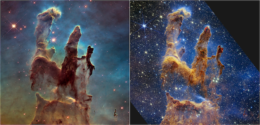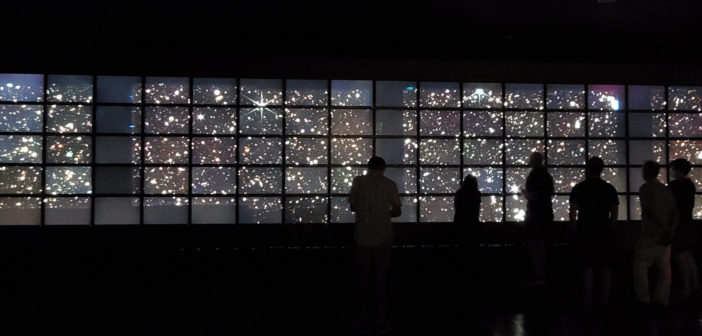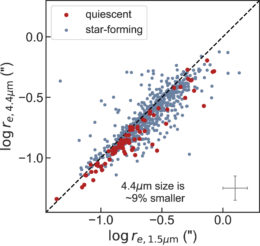How do galaxies grow? It’s a simple question, but answering it is complicated. A recent publication suggests that JWST observations might upend what we think we know about galaxy growth.
Evolution Seen from Afar

Comparison of Hubble (left) and JWST (right) images of the Pillars of Creation. The different wavelength ranges spanned by Hubble and JWST have the potential to illuminate different aspects of many cosmic settings. [Science: NASA, ESA, CSA, STScI, Hubble Heritage Project (STScI, AURA); Image processing: Joseph DePasquale (STScI), Anton M. Koekemoer (STScI), Alyssa Pagan (STScI)]
Observations with the Hubble Space Telescope helped establish some fundamental rules of galaxy growth: galaxies were smaller in the past than they are today, galaxies that are more massive are usually larger, and galaxies that are actively forming stars are larger than those that are not. But constraints set by Hubble’s observing wavelength range might mean that these rules are due for a reassessment, and JWST is poised to put them to the test.
JWST Enters the Scene
When Hubble observes galaxies in the early universe, it’s seeing light emitted at optical and ultraviolet wavelengths, while JWST sees light that originated in the near-infrared. This small difference might have a big impact: near-infrared light is a better tracer of stellar mass than optical or ultraviolet light, and it’s less sensitive to spatial changes in the mass-to-light ratio seen in some galaxies. Ultimately, when combined with its exceptional resolution, this means that JWST should provide more reliable measurements of galaxy sizes than other telescopes.
Using data from the JWST Cosmic Evolution Early Release Science (CEERS) program, Katherine Suess (University of California, Santa Cruz, and Stanford University) and collaborators studied galaxies during an era commonly nicknamed cosmic noon, which is marked by an abundance of star formation. The team’s goal was to determine the sizes of galaxies during this epoch at two different wavelengths (1.5 and 4.4 microns; 1 micron = 10-6 meter) that correspond to light emitted in the optical and near-infrared, respectively.

The galaxies surveyed are situated in the Extended Groth Strip, which was previously observed by Hubble. Click to enlarge. [NASA, ESA, and M. Davis (University of California, Berkeley)]
How Do They Measure Up?
Suess and coauthors selected 1,179 bright galaxies with redshift, z, between 1.0 and 2.5 and used a computer algorithm to measure the sizes of these galaxies in the 1.5- and 4.4-micron JWST images. For the 703 galaxies successfully fit by this method, there was a definite size difference between the two wavelengths: the galaxies were, on average, 9% smaller in the 4.4-micron images than in the 1.5-micron images. This means that galaxies are more compact than rest-frame optical observations (e.g., Hubble observations) would suggest. Intriguingly, the difference in size between the two wavelengths appears to be a function of galaxy mass and color — the lightest, bluest galaxies surveyed scarcely show a size change, while those that are redder and more massive show a 30% size decrement at the longer wavelength.This seemingly straightforward finding might play a role in rewriting the rules of galaxy evolution. For instance, the mass-dependent size decrease between the 1.5- and 4.4-micron images might mean that massive galaxies aren’t actually much larger than their lighter counterparts! While the authors stress that there’s more analysis to be done, it’s clear that JWST observations will have an outsize impact on our understanding of galaxy growth.
Citation
“Rest-frame Near-infrared Sizes of Galaxies at Cosmic Noon: Objects in JWST’s Mirror Are Smaller than They Appeared,” Katherine A. Suess et al 2022 ApJL 937 L33. doi:10.3847/2041-8213/ac8e06

